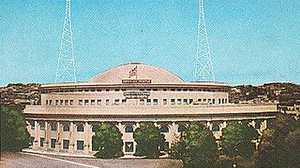Religious Worship and American Race Relations

Butler: The Azusa Street revival... started in April, 1906, with a group of African American washpeople... When the Azusa Street revival happened and Pentecostalism came to Los Angeles, it was a new thing... You had people being slain in the spirit, falling on the ground, speaking in tongues, holding hands with each other, gender barriers were broken, racial barriers were broken...
It's this ecstatic free worship, a touch of the body, bodies touching where you had not had that so much in religious services before. And second is the interracial component of the revival. That... sets a stage... In one sense, the tensions that arise between African Americans and whites, Asian Americans, Latinos. But on the other hand, it opens up new vistas for the people who come to the revival to have another experience that they would not have had before.
When [the Azusa Street revival] happens, you see a totally different experience in Los Angeles than you've ever seen before. You see racial mixing, you see an African American man, William J. Seymour, leading the revival. You see women as well as men as a part of the board of the Azusa Street mission... The established churches hated it, because it took numbers away from them. People did not like it. The newspapers hated it because they talked about the race mixing, women leaving their husbands. There's an amalgamation of, how do they put it, "Caucasian insanity and black voodoo..."
Sutton: Aimee has launched a nationwide revival tour in the 1910s and she finally moves into the South... she's holding huge revivals, people are turning out in record numbers to see her.
[In Florida], Aimee decides to move into the African-American part of town to hold a revival... But she is so interesting, she's so exciting, she has so captivated the white folks in town that they follow her. They decide to defy... the Jim Crow laws that they had established...
So in this one tent for the first time, she claims, in Florida we have whites and blacks worshipping side by side. She says, "Glory, the walls of prejudice are finally coming down..."
During her revivals in the South Aimee was so interested in racial reconciliation and working with all people that she actually recruited an African American minister to baptize her daughter Roberta in one of the local rivers... this really becomes a symbol of Aimee's effort to work with all people, of all races, creeds, cultures, and classes.
Butler: Sister Aimee has a big year in 1936. It's the 50th anniversary of the Azusa Street revival and as one of the leading ladies... of Pentecost, she decided that she'll hold a big anniversary meeting in Angelus Temple. And this is a time when she begins to reach back to a community that she's forgotten a little bit about in the Twenties, and that's the African American community. She invites several speakers to come to Angelus Temple to preach and be on the pulpit, and she begins to reach back to that community...
She reaches back to where she began, with the downtrodden peoples, and especially the African Americans who had been there to help her put up her tents, to take down her tents, to minister with her, and to give out of what they had. She goes back to this community again, and in a sense it's her finding her ground once again.







